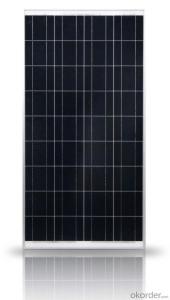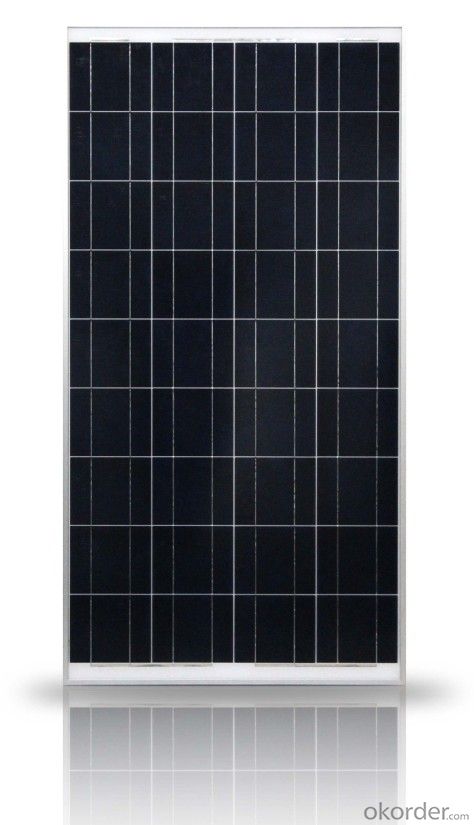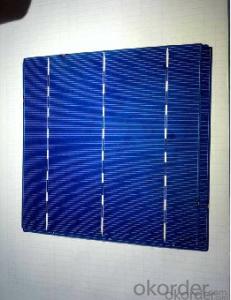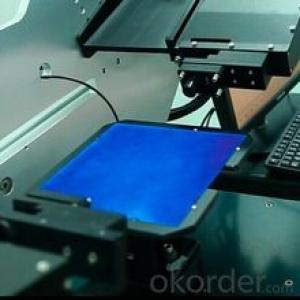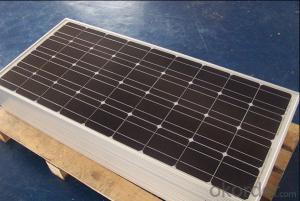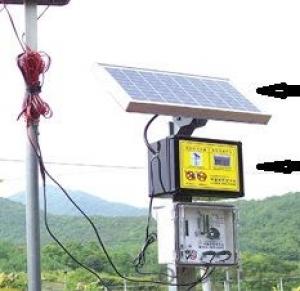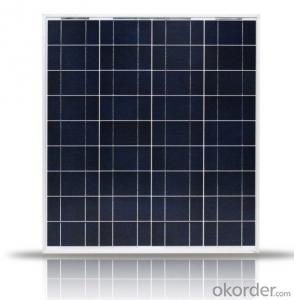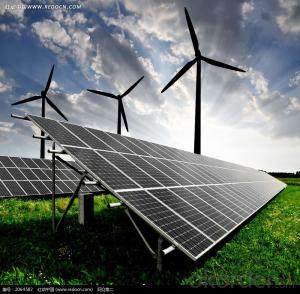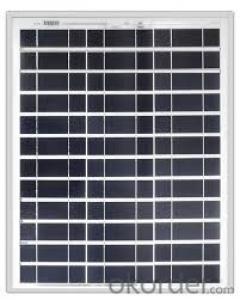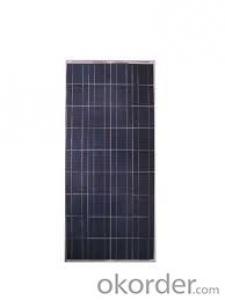Factory Direct Sale Poly Solar Panel with 25 Years Warranty CNBM - Solar Cells South Africa
- Loading Port:
- Qingdao
- Payment Terms:
- TT OR LC
- Min Order Qty:
- 10 set
- Supply Capability:
- 300000 set/month
OKorder Service Pledge
OKorder Financial Service
You Might Also Like
Polycrystalline Solar Modules
CNBM offers a range of small, medium and large polycrystalline solar modules, designed for a range of requirements.
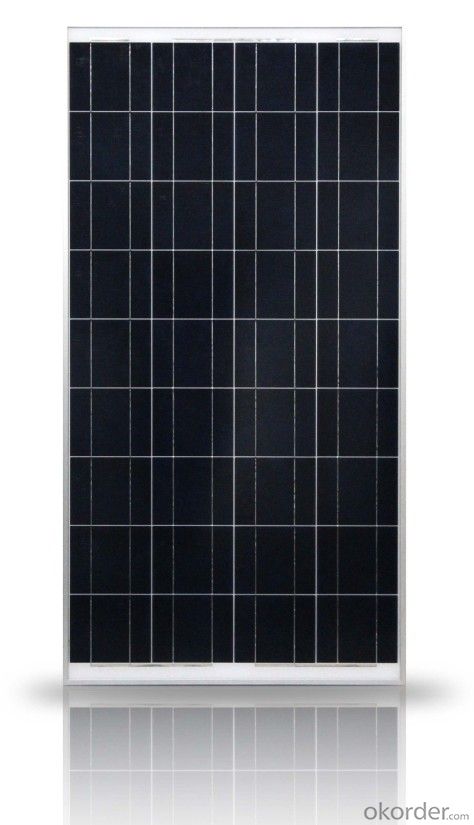
Specifications:
Tolerance | +/-3% |
Cell | Polycrystalline silicon solar cells (156 x 156mm) |
N0. of Cells | 60 (10 x 6) |
Dimension of Modules (mm) | 1650 x 990 x 40 |
Weight (kg) | 25.5 |
Limits:
Operating Temperature | -40~+85? |
Storage Temperature | -40~+85? |
Maximum System Voltage | 1000 VDC max. |
Hail Impact | Diameter of 28mm with impact speed |
Temperature and Coefficients:
NOCT | 48C+/-2? |
Voltage temperature coefficient (%/K) | -0.35 |
Current temperature coefficient (%/K) | 0.05 |
Power temperature coefficient (%/K) | -0.45 |
Characteristics:
Model: | SGM-200P | SGM-210P | SGM-220P |
Max-power voltage Vmp (V) | 29.2 | 29.4 | 29.41 |
Max-power current Imp (A) | 6.85 | 7.14 | 7.48 |
Open-circuit voltage Voc (V) | 36.5 | 36.69 | 36.9 |
Short-Circuit Current Isc (A) | 7.28 | 7.6 | 7.93 |
Max-power Pm(W) | 200 | 210 | 220 |
Model: | SGM-230P |
Max-power voltage Vmp (V) | 29.8 |
Max-power current Imp (A) | 7.72 |
Open-circuit voltage Voc (V) | 37.31 |
Short-Circuit Current Isc (A) | 8.19 |
Max-power Pm(W) | 230 |
STC: Irradiance 1000W/m2, module temperature 25?, AM-=1.5
Poly Crystalline Solar Panels Specifications Range
Maximum Power (Pm) | Dimension | Weight | Operating Voltage (Vmp) | Operating Current (Imp) | Open Circuit Voltage (Voc) | Short Circuit Current (Isc) |
0.45W | 140x80x10mm | 0.08kg | 3.3V | 150mA | 4.6V | 160mA |
1.0W | 162x140x10mm | 0.16kg | 7.5V | 150mA | 10.3V | 160mA |
4.5W | 269x251x23mm | 0.8kg | 16.5V | 0.27A | 20.5V | 0.3A |
10W | 420.1×268.9×22.6mm | 1.92kg | 17.5V | 0.58A | 20.5V | 0.6A |
20W | 425x502x50mm | 3.0kg | 16.8V | 1.19A | 21.0V | 1.29A |
30W | 593x502x22.6mm | 3.9kg | 16.8V | 1.78A | 21.0V | 1.94A |
40W | 655x537x50mm | 5.75kg | 17.3V | 2.31A | 22.1V | 2.54A |
50W | 839x537x50mm | 6.0kg | 17.5V | 2.9A | 21.8V | 3.17A |
65W | 1111x502x50mm | 7.2kg | 17.6V | 3.69A | 22.1V | 3.99A |
80W | 1204x537x50mm | 7.7kg | 17.6V | 4.55A | 22.1V | 4.8A |
- Q: How do solar cells contribute to reducing greenhouse gas emissions?
- Solar cells contribute to reducing greenhouse gas emissions by converting sunlight directly into electricity without any emissions of greenhouse gases. This renewable energy source replaces the need for fossil fuels, such as coal and natural gas, which release carbon dioxide and other harmful gases when burned for electricity generation. By harnessing the power of the sun, solar cells provide a clean and sustainable alternative, helping to mitigate climate change and reduce our carbon footprint.
- Q: What is a High-efficiency electric solar cell panel?
- One requirement should be transparent toughened glass and anticorrosive EVA protect the battery panels effectively.
- Q: What is a monocrystalline solar cell?
- A monocrystalline solar cell is a type of solar cell made from a single crystal structure, typically of silicon. It is known for its high efficiency in converting sunlight into electricity due to its uniform crystal lattice structure, which allows for better electron flow. Monocrystalline solar cells are widely used in photovoltaic systems due to their excellent performance and durability.
- Q: How are solar cells connected in a solar panel?
- Solar cells are connected in a solar panel through a series of electrical connections called interconnects. These interconnects form a circuit that allows the flow of electrons between the individual solar cells, ensuring that the electrical current generated by each cell is combined to produce a higher voltage and power output.
- Q: Can solar cells be used for off-grid applications?
- Yes, solar cells can indeed be used for off-grid applications. Solar cells convert sunlight into electricity, which can be stored in batteries for later use. This capability makes them ideal for powering off-grid applications such as remote cabins, RVs, and even small electronic devices like calculators and outdoor lighting. By harnessing the power of the sun, solar cells offer a sustainable and reliable energy source for off-grid situations.
- Q: What is the impact of temperature fluctuations on solar cell efficiency?
- Temperature fluctuations can have a significant impact on solar cell efficiency. As temperature increases, the efficiency of solar cells tends to decrease. This is because higher temperatures can cause an increase in the resistance of the materials used in solar cells, leading to a decrease in the overall power output. Additionally, temperature fluctuations can also lead to thermal stress and expansion, which can potentially damage the solar cells and further reduce their efficiency. Therefore, it is important to consider and manage temperature fluctuations to optimize the performance of solar panels.
- Q: What is the impact of solar cells on job creation?
- The impact of solar cells on job creation is significant. The solar industry has seen a rapid growth in recent years, leading to a surge in job opportunities. Solar cell manufacturing, installation, maintenance, and research and development have all created a wide range of employment opportunities. This growth has not only created jobs in the renewable energy sector but has also generated indirect employment in related industries. Additionally, the shift towards solar energy has encouraged innovation and entrepreneurship, further contributing to job creation. Overall, solar cells have had a positive impact on job creation by driving economic growth and fostering a sustainable workforce.
- Q: What's the benefit of using a solar cell?
- It can decrease the damage to our environment.
- Q: How do solar cells handle voltage fluctuations?
- Solar cells handle voltage fluctuations through the use of voltage regulators or charge controllers. These devices ensure that the voltage output from the solar cells remains stable and within a safe range by regulating the flow of current. This helps to protect the solar cells from damage and ensures efficient power generation.
- Q: What is the impact of solar cell installations on greenhouse gas emissions?
- Solar cell installations have a significant positive impact on reducing greenhouse gas emissions. By harnessing clean and renewable energy from the sun, solar cells help to displace the use of fossil fuels, which are major contributors to greenhouse gas emissions. This transition to solar power leads to a decrease in carbon dioxide and other harmful emissions, helping to mitigate climate change and improve air quality.
Send your message to us
Factory Direct Sale Poly Solar Panel with 25 Years Warranty CNBM - Solar Cells South Africa
- Loading Port:
- Qingdao
- Payment Terms:
- TT OR LC
- Min Order Qty:
- 10 set
- Supply Capability:
- 300000 set/month
OKorder Service Pledge
OKorder Financial Service
Similar products
Hot products
Hot Searches
Related keywords
